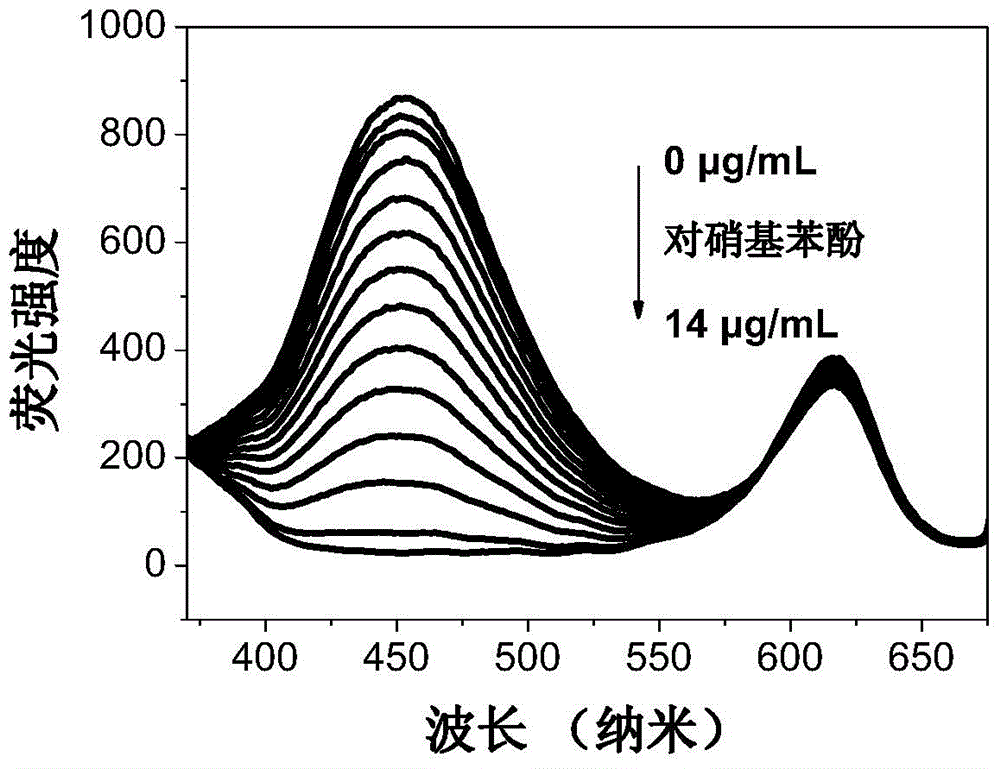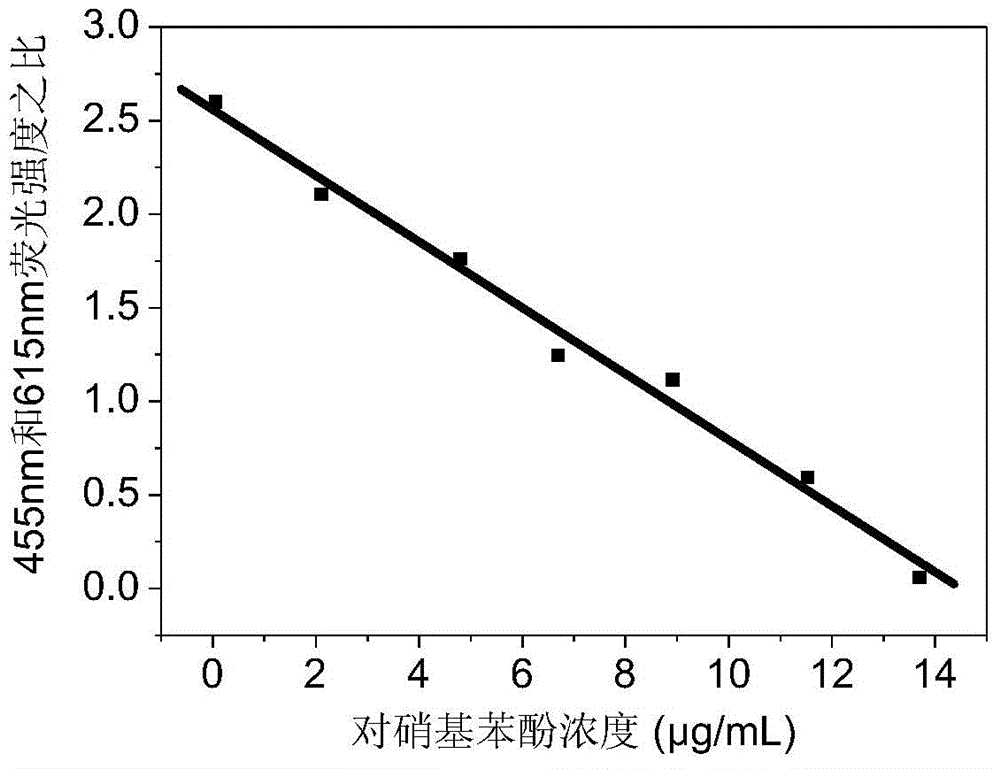Method for detecting p-nitrophenol based on molecular imprinting ratio type fluorescent probe
A technology of p-nitrophenol and molecular imprinting, which is applied in the direction of fluorescence/phosphorescence, material excitation analysis, etc., and can solve the problem of reducing the selectivity of the detection process
- Summary
- Abstract
- Description
- Claims
- Application Information
AI Technical Summary
Problems solved by technology
Method used
Image
Examples
Embodiment 1
[0025] A method for detecting p-nitrophenol based on molecularly imprinted ratiometric fluorescent probes, the steps are as follows:
[0026] (1) Preparation of fluorescent silica nanoparticles coated with quantum dots;
[0027] Fluorescent silica nanoparticles coated with quantum dots are prepared by adopting the methods of published Chinese patents (authorized notification numbers: CN102757790B and CN1306002C).
[0028] (2) Preparation of siloxane functionalized carbon dots;
[0029] Siloxane functionalized carbon dots were prepared by adopting the method of the published Chinese patent (publication number: CN103421495A).
[0030] (3) Preparation of core-shell dual-emission fluorescent silica nanoparticles;
[0031] Take 5 mg of fluorescent silica nanoparticles coated with quantum dots obtained in step (1) and ultrasonically disperse them in 50 mL of anhydrous toluene, add 5 μL of siloxane functionalized carbon dots obtained in step (2), stir evenly, and heat to Reflux te...
Embodiment 2
[0037] (1) Preparation of fluorescent silica nanoparticles coated with quantum dots;
[0038] Fluorescent silica nanoparticles coated with quantum dots are prepared by adopting the methods of published Chinese patents (authorized notification numbers: CN102757790B and CN1306002C).
[0039] (2) Preparation of siloxane functionalized carbon dots;
[0040] Siloxane functionalized carbon dots were prepared by adopting the method of the published Chinese patent (publication number: CN103421495A).
[0041] (3) Preparation of core-shell dual-emission fluorescent silica nanoparticles;
[0042]Take 5 mg of fluorescent silica nanoparticles coated with quantum dots obtained in step (1) and ultrasonically disperse them in 100 mL of anhydrous toluene, add 15 μL of the siloxane functionalized carbon dots obtained in step (2), stir evenly, and heat to Reflux temperature, after 16 hours of reaction, the product was centrifuged to obtain 5.9 mg of solid powder of core-shell dual-emission flu...
Embodiment 3
[0048] (1) Preparation of fluorescent silica nanoparticles coated with quantum dots;
[0049] Fluorescent silica nanoparticles coated with quantum dots are prepared by adopting the methods of published Chinese patents (authorized notification numbers: CN102757790B and CN1306002C).
[0050] (2) Preparation of siloxane functionalized carbon dots;
[0051] Siloxane functionalized carbon dots were prepared by adopting the method of the published Chinese patent (publication number: CN103421495A).
[0052] (3) Preparation of core-shell dual-emission fluorescent silica nanoparticles;
[0053] Take 5 mg of fluorescent silica nanoparticles coated with quantum dots obtained in step (1) and ultrasonically disperse them in 75 mL of anhydrous toluene, add 10 μL of siloxane functionalized carbon dots obtained in step (2), stir evenly, and heat to Reflux temperature, after 12 hours of reaction, the product was centrifuged to obtain 5.8 mg of solid powder of core-shell dual-emission fluores...
PUM
 Login to View More
Login to View More Abstract
Description
Claims
Application Information
 Login to View More
Login to View More - R&D
- Intellectual Property
- Life Sciences
- Materials
- Tech Scout
- Unparalleled Data Quality
- Higher Quality Content
- 60% Fewer Hallucinations
Browse by: Latest US Patents, China's latest patents, Technical Efficacy Thesaurus, Application Domain, Technology Topic, Popular Technical Reports.
© 2025 PatSnap. All rights reserved.Legal|Privacy policy|Modern Slavery Act Transparency Statement|Sitemap|About US| Contact US: help@patsnap.com



